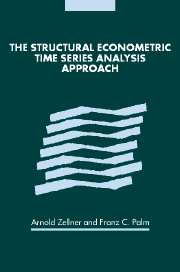Book contents
- Frontmatter
- Contents
- List of contributors
- Acknowledgments
- Introduction
- Part I The SEMTSA approach
- Part II Selected applications
- Part III Macroeconomic forecasting and modeling
- Part IV Disaggregation, forecasting, and modeling
- 20 Using Bayesian techniques for data pooling in regional payroll forecasting (1990)
- 21 Forecasting turning points in metropolitan employment growth rates using Bayesian techniques (1990)
- 22 A note on aggregation, disaggregation, and forecasting performance (2000)
- 23 The Marshallian macroeconomic model (2000)
- 24 Bayesian modeling of economies and data requirements (2000)
- Subject index
- Author index
- References
23 - The Marshallian macroeconomic model (2000)
Published online by Cambridge University Press: 24 October 2009
- Frontmatter
- Contents
- List of contributors
- Acknowledgments
- Introduction
- Part I The SEMTSA approach
- Part II Selected applications
- Part III Macroeconomic forecasting and modeling
- Part IV Disaggregation, forecasting, and modeling
- 20 Using Bayesian techniques for data pooling in regional payroll forecasting (1990)
- 21 Forecasting turning points in metropolitan employment growth rates using Bayesian techniques (1990)
- 22 A note on aggregation, disaggregation, and forecasting performance (2000)
- 23 The Marshallian macroeconomic model (2000)
- 24 Bayesian modeling of economies and data requirements (2000)
- Subject index
- Author index
- References
Summary
In this paper, background information on the origins and features of the Marshallian Macroeconomic Model (MMM) are presented. MMMs based on two alternative production functions are presented and compared. In addition, some empirical forecasting results for one of them are reviewed. Last, attention is focused on further development and implementation of the MMM.
Introduction
It is an honor and a pleasure to present my paper at this research conference honoring Professor Ryuzo Sato, a superb colleague and most productive scholar. His outstanding research analyzing production and technological change, Sato (1999a, 1999b) has been appreciated worldwide. Indeed, these topics play a central role in almost all models of industrial sectors and economies, including the models to be discussed below.
On the origins of the [Marshallian Macroeconomic Model] (MMM), in my experience it was a pleasure teaching undergraduate and graduate students the properties and uses of the Marshallian model of a competitive industry. On the other hand, teaching students macroeconomics was quite a different matter since there was no such comparable, operationally successful model available (See, e.g., Belongia and Garfinkel 1992 for an excellent review of alternative macroeconomic models, including monetarist, neo-monetarist, Keynesian, post-Keynesian, and real business cycle models and Fair 1992 and Zellner 1992, who pointed out that not enough empirical testing of alternative models had been done and more is needed to produce macroeconomic models that explain the past, predict well, and are useful in making policy.)
- Type
- Chapter
- Information
- The Structural Econometric Time Series Analysis Approach , pp. 667 - 676Publisher: Cambridge University PressPrint publication year: 2004



